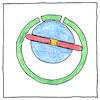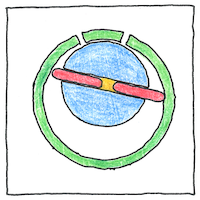Charles C. Barnes
mechanics

|
Rotary vane pump
Put a rotor in a chamber with vanes extending from the rotor and pressing the chamber wall to move a liquid, creating an expanding chamber to pull liquid in, and a contracting chamber to squeeze liquid out.
Positive displacement pump
A constant flow machine produces the same flow at a given speed regardless of the discharge pressure—in theory. Because it relies on moving seals, an increase of discharge pressure can slightly decrease the flow as fluid leaks around the seals—in practice.
Eccentricity
If the center of the rotor is not at the center of the chamber and the vanes are pushed by springs against the chamber wall unequal partitions—intake and discharge—improve efficiency. I think the same advantage cannot be claimed for people with eccentric behaviors—must be there are other reasons we love them.



The human heart is a positive-displacement pump that works like a diaphragm or membrane pump, employing one-way valves on both sides of a flexible diaphragm.
See also in The book of science:
Readings in wikipedia:
Other readings: